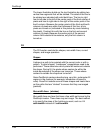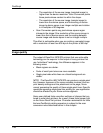
PostScript
Guide to Using Page Description Languages 1-27
It is often difficult to determine if a PostScript master uses user-
defined fonts. To do so requires studying the master in detail,
unless the creator has followed the standards suggested in the
PostScript reference manual and specified the fonts used by the
document in a PostScript comment format. An example of this
format is:
%%DocumentFonts: { <
fontname
> ...}
%%DocumentSuppliedFonts:{ <
fontname
> ...}
However, if the character shapes seem poorly rasterized, user-
defined fonts probably are contained in the master. When
possible, use Type 1 fonts, which are rasterized through special
techniques, for best output quality.
Note that the DocuPrint PostScript interpreter applies thickening
to certain graphics-rendering operations. For example, outline
fonts in the Type 1 format are subject to rasterization techniques
that use thickening for best quality of text rendering on Xerox
devices.
Rendering of color and gray values: transform function
PostScript devices approximate source color values by a
sampling and halftoning technique. These values can be
modified by changing the output transfer function. The transfer
function permits the correction of color (including gray) values to
compensate for nonlinear color (and gray) level response in both
an output device and the human eye.
The color levels presented to the
setcmykcolor
,
sethsbcolor
,
setrgbcolor
, and
setgray
operators and appearing as sampled
data are not used directly, but are mapped through the current
transfer functions. The resulting output consists of combinations
of black and white on the DocuPrint monochrome printer, and
black, white, and highlight color on the DocuPrint highlight color
printers.
NOTE: The internal default transfer function in DocuPrint cannot
be bypassed. Currently, there is an internal table that is used for
converting input requests for a color value to a different number
that is used to set the output device color level.
On the DocuPrint monochrome printers, PostScript masters that
rely on the null transfer function (null transfer function is {}
settransfer
) do not overwrite the internal transfer function.


















